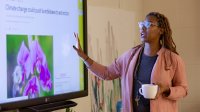Boosting Critical Thinking Across the Curriculum
Visible thinking routines that encourage students to document and share their ideas can have a profound effect on their learning.
Your content has been saved!
Go to My Saved Content.In my coaching work with schools, I am often requested to model strategies that help learners think deeply and critically across multiple disciplines and content areas. Many teachers are looking to adapt research-based methods to help students think about content in meaningful ways by making connections to previous learning, asking relevant questions, displaying understanding through learning artifacts, and identifying their challenges with the material.
Educator Alfred Mander said, “Thinking is skilled work. It is not true that we are naturally endowed with the ability to think clearly and logically—without learning how and without practicing.”
Visible thinking routines can be an excellent and simple way to start using systematic but flexible approaches to teaching thinking dispositions to young people at any grade level. Focusing on thinking types, powerful routines can strengthen learners’ ability to analyze, synthesize (design), and question effectively. Classroom teachers want these skills to become habits, making students the most informed stakeholder in their own learning.
Not to be confused with visible learning research by John Hattie, Visible Thinking is a research-based initiative by Harvard’s Project Zero with more than 30 routines aimed at making learning the consequence of good thinking dispositions. Students begin to comprehend content through thinking routines composed of short questions or a series of steps. During routines, their learning becomes visible because their ideas are documented, voiced, discussed with others, and reflected on.
For example, the routine See, Think, Wonder can be used to get students to analyze and interpret graphs, text, infographics, or video during the entry event of project-based learning units or daily lessons. Guiding students to have rich and lively discussions about their thoughts, interpretations, and wonderings (questions) can help teachers decide on appropriate lessons and next steps.
Another effective visible thinking routine is Connect, Extend, Challenge (CEC). Learners can use CEC to organize, clarify, and simplify complex information on graphic organizers. The graphic organizer becomes a kinesthetic activity for creating an informational artifact that students can refer to as the lesson or unit progresses.
Here are some creative but simple ways to carry out these two routines across multiple classrooms.
See, Think, Wonder
See, Think, Wonder can be leveraged as a thinking routine to launch engagement and inquiry in daily lessons by introducing an interesting object (graphic, artifact, etc.). The idea is for students to think carefully about why the object looks or is a certain way. Teachers introduce the following question prompts to guide students’ thinking:
- What do you see?
- What do you think about that?
- What does it make you wonder?
When the routine is new, sometimes young children may not know where to begin expressing themselves—this is where converting the above question prompts into sentence stems, “I see…,” “I think…,” and “I wonder…,” comes into play. For students struggling with analytical skills, it’s empowering for them to accept themselves where they currently are—learning how to analyze critically can be achieved over time and with practice. Teachers can help them build confidence with positive reinforcement.
Adapt the routine to meet the needs of your kids, which may be to have them work individually or to engage with classmates. I use it frequently—especially when introducing emotionally compelling graphics to students learning about environmental issues (e.g., the UN’s Goals for Sustainable Development) and social issues. This is useful in helping them better understand how to interpret graphs, infographics, and what’s happening in text and visuals. Furthermore, it also promotes interpretations, analysis, and questioning.
Content teachers can use See, Think, Wonder to get learners thinking critically by introducing graphics that reinforce essential academic information and follow up the routine with lessons and scaffolds to support students’ ideas and interpretations.
Connect, Extend, Challenge
CEC is a powerful visible learning routine to help students connect previous learning to new learning and identify where they are struggling in various educational concepts. Taking stock of where they are stuck in the material is as vital as articulating their connections and extensions. Again, they might struggle initially, but here’s where front-loading vocabulary and giving them time to talk through challenges can help.
A good place to introduce CEC is after students have analyzed or observed something new. This works as a natural next step to have them dig deeper with reflection and use what they learned in the analysis process to create their own synthesis of ideas. I also like to use CEC after engaging them in the See, Think, Wonder routine and at the end of a unit.
Again, learners can work individually or in small groups. Teachers can also have them move into the routine after reading an article or some form of targeted informational text where the learning is critical to moving forward (e.g., proportional relationships, measurement, unit conversion). Regardless of your approach, Project Zero suggests having learners reflect on the following question prompts:
- How is the _____ connected to something you already know?
- What new ideas or impressions do you have that extended your thinking in new directions?
- What is challenging or confusing? What do you need to improve your understanding?
I like to have learners in small groups answer a version of the question prompts in a simple three-column graphic organizer. The graphic organizer can also become a road map for prioritizing the next steps in learning for students of all ages. Here are some visual examples of how I used the activity with educators in a professional development session targeting emotional intelligence skills.
More Visible Thinking Resources
- Project Zero’s Thinking Routine Toolbox: Access to core thinking routines
- Making Thinking Visible: How to Promote Engagement, Understanding, and Independence for All Learners, by Ron Ritchhart, Mark Church, and Karin Morrison
- Creating Cultures of Thinking: The 8 Forces We Must Master to Truly Transform Our Schools, by Ron Ritchhart
